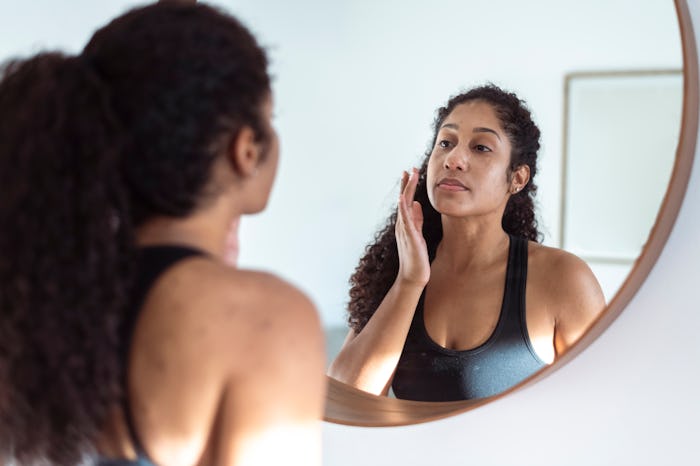Breastfeeding

Acne After Weaning Is *Totally* A Thing
You can thank those pesky hormones again.
Breastfeeding comes with a wide range of benefits, including unmatched nutritional value for your little one and maximum bonding time. But what happens when you stop breastfeeding? Usually, another shift in hormones means another wide range of body changes, potentially resulting in depression, PMS, fatigue, and mood swings. Oh, and another big one? Acne. A lot of moms face (no pun intended) post-breastfeeding skin issues, so if you're experiencing acne after weaning, just know that you are not alone.
Hormonal changes while weaning
So, why are you experiencing acne for the first time since your high school years?
“Acne is caused by a build-up of sebum or oil that’s naturally produced by the body and released through pores,” says Dr. Michele Green, M.D., a cosmetic dermatologist in New York City. “We’re often left with an unsightly, swollen, irritated pimple when a pore becomes clogged and the oil becomes trapped. Acne is a common occurrence after weaning due to the huge fluctuation in hormones that happens during this period.”
While you’re breastfeeding, your body is producing a large amount of prolactin and oxytocin, Green says. Prolactin is the hormone responsible for the production of breast milk and the release of oxytocin during breastfeeding. And once the weaning process begins, there’s a shift in hormone production because there’s less prolactin and oxytocin being made, and there’s a surge in the production of progesterone and estrogen.
Since the body is sensitive to such shifts, there can be some side effects, Green explains, like an increase in the amount of sebum your skin is producing. In turn, this can clog your pores and make them inflamed, causing acne while weaning.
Treatment options for acne after weaning
You may find that you don’t need any treatment at all. “Hormonal acne that occurs after weaning may resolve on its own after the body’s hormone production swings back into a natural balance,” says Green. However, she adds that hormonal acne can be painful to the touch and cause feelings of self-consciousness. So, how can you effectively treat acne if it doesn’t go away on its own?
“A consultation with a dermatologist like myself can help you determine which combination of treatments will work best for you,” Green says. “Adjusting your skin care regimen to include the proper cleansers, exfoliators, and treatment products — such as benzoyl peroxide, topical retinoids, and exfoliants — can be beneficial, but it’s important to discuss with a professional which treatment products are best for your skin type to gain optimal results.”
“One could try using anti-inflammatory treatments to calm the breakouts — topical antibiotics like clindamycin or azelaic acid. However, because acne that flares with weaning is hormonal, one would need to target the hormonal causes for the breakouts,” says Dr. Nancy Shannon, M.D., PhD, medical advisor for Nurx.
You should also ask your provider about whether hormonal birth control pills or spironolactone, which appears acceptable to take during breastfeeding, might help, especially if the acne is widespread or is starting to leave scars, Shannon says.
If you know you’re prone to hormonal acne, take that into account when you’re thinking about weaning, and take a slow and steady approach. A sudden or abrupt stop in breastfeeding can lead to a host of problems, including a face full of hormonal acne, according to La Leche League. So, slowly weaning may be beneficial to your hormone levels, and in turn, your skin.
Other causes of post-weaning breakouts
Another potential cause of post-weaning breakouts could be undiagnosed polycystic ovarian syndrome (PCOS) which, according to the World Health Organization, affects 8 to 13% of women who are of childbearing age. But, again, it all comes down to your hormones and whether or not they’re balanced.
Skincare routine while breastfeeding
Stick to products formulated for sensitive skin, experts say. “Fragrance-free, non-comedogenic products should be used,” Green says. She adds that breastfeeding recommendations vary from what’s recommended during pregnancy, so be sure to consult with your dermatologist before using a skincare product or treatment.
“Topical chemicals on the skin can theoretically get into breast milk; however, given the small surface area for which acne medications are applied, this is generally not an issue,” Shannon says, suggesting treatments such as alpha hydroxy acids (like glycolic acid), azelaic acid, benzoyl peroxide, or topical erythromycin, because they are generally considered safe to use during breastfeeding.
The consensus is clear: you can break out if you stop breastfeeding, thanks to the rapid fluctuation of hormones. That’s why gradual weaning is recommended if you want to keep your breakouts at bay. Slowly phasing out feedings gives your body the chance to get used to the changes and, as a result, lowers your chances of experiencing severe acne flare-ups. If you do experience persistent acne that doesn’t seem to clear after your hormones should’ve returned to normal, you should talk to your physician about alternative treatments or medication.
Experts:
Dr. Michele Green, M.D., a cosmetic dermatologist in New York City
Dr. Nancy Shannon, M.D., PhD, medical advisor for Nurx
This article was originally published on